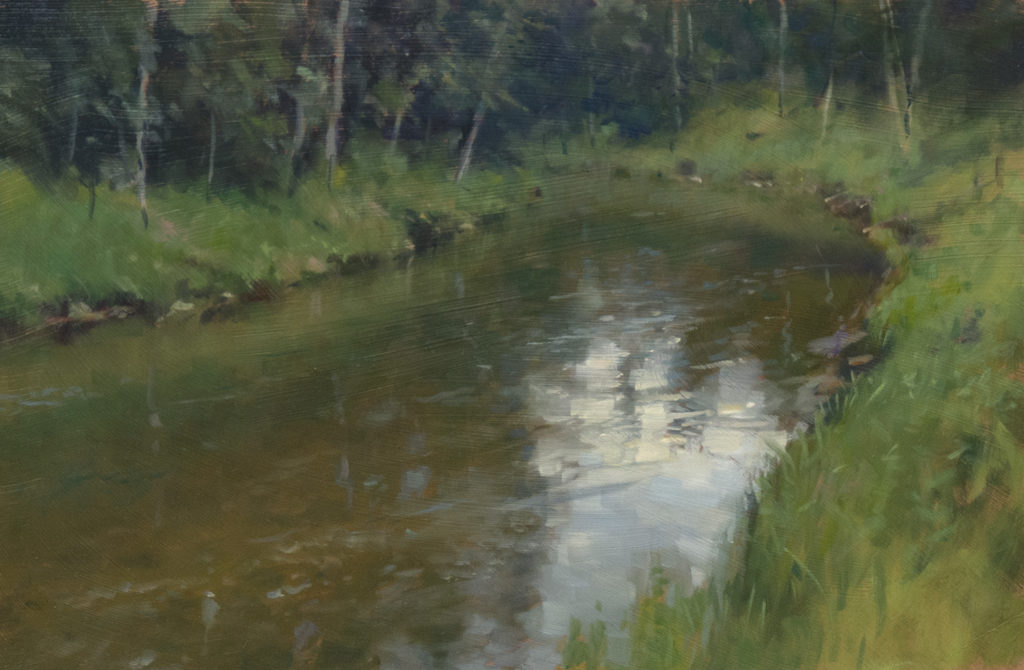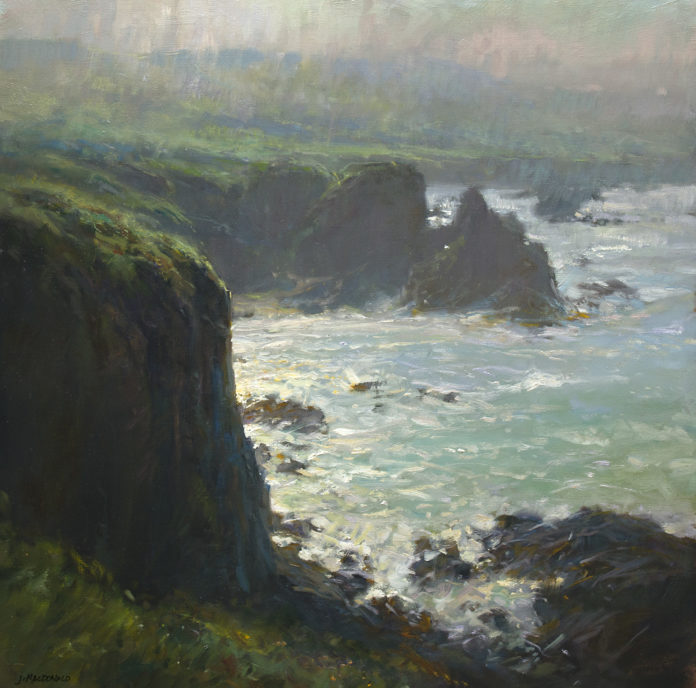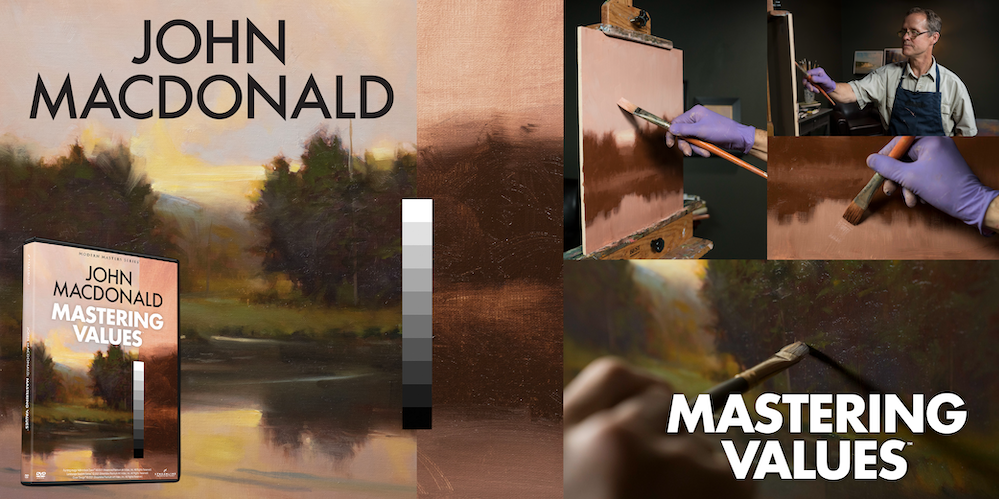On composition and painting values > A landscape painter of 40 years shares his expert advice on understanding painting composition:
John MacDonald has never tired of trying to capture the beauty and tranquility of the natural world.
“Creating a painting isn’t magic – there are certain steps you can take, and certain skills you acquire, and putting them together will lead to a good painting.” ~John MacDonald, from his new art video workshop, “Mastering Values”
The following is an excerpt from his newsletter on how to paint the landscape.
Painting Composition: Get Into 2-D
Painting is an art and a craft. As for the art, I can’t teach anyone anything. The art needs to arise from your soul and I can’t reach there. But as a craft, painting is very teachable. It’s a process that can be broken down into steps; each can be understood and applied. Painting isn’t easy but it really is rather simple. Think of running a sub-4:00 mile. What could be more simple than running four circles around a track? But to do it in under 4 minutes requires years of training and focused effort. Painting is a similar pursuit: simple but not easy, and it all begins with theory.
We can’t paint what we can’t see and we can’t see if we don’t know what to look for. Learning to paint begins with intellectually understanding concepts. Once grasped, we then learn to see those concepts in action in the scene or in the paintings of others. It ends with our applying what we’ve learned to see to our own paintings. (Actually, that’s the real beginning of painting, but that’s another story.)
It’s true that theory can be a problem. In the yearning to make painting easier and to avoid looking inept, we can allow theory to become a chain of rules that binds our creativity and stops our artistic growth – we become formula painters. But a it’s risk we must take because, like it or not, learning to paint begins with theory, with concepts.
In my never-ending (and ultimately fruitless) attempt to understand what makes a painting great, I’ve been looking at the differences between 2-D and 3-D seeing, thinking, and painting.
“Go by what the eye sees instead of what the brain knows and it will result in a better painting.” ~John MacDonald, from “Mastering Values”
Forget Right/Left Brain: Think 2-D/3-D brain.
We’ve all heard of the right brain–left brain split: the subjective and intuitive right brain versus the objective and analytical left brain. It’s often, and incorrectly, assumed we artists live and work solely from our right brains. In practice, we need both. We must be able to switch effortlessly between right and left brain as we work, staying in the creative right brain while we paint and switching to our analytical and objective left brain to judge the quality of each of our painting decisions. This back and forth movement of painting and judging is a delicate dance that continues until the work is considered finished.
A less well known but equally important brain duality is that of 2-D and 3-D modes of seeing and thinking. When in 2-D mode, we see an image or scene as a series of flat, simple shapes that exist in a single plane in space, like a jigsaw puzzle lying on a table. There is no foreground or background, only left, right, up and down.
When in 3-D mode, we see an image or scene in terms of the illusions of deep space, three-dimensional form, of light and atmosphere. In 3-D mode, the flat surface of the canvas becomes a transparent window through which we see a believable, representational, three-dimensional world. The ability to see and think in both modes is crucial because the painting process requires both and every great painting contains both.
To continue reading John’s newsletter on how to “Get Into 2-D” (May/June 2020), visit www.jmacdonald.com.

On Painting Values
During his 40 years of experience painting landscapes – and having his fair share of bad ones — John MacDonald became MORE curious about what was it that separated the good from the GREAT paintings.
What was it that was so captivating about the work of the great artists? How did they capture attention and inspire a sense of awe?
Over the years, John MacDonald has found the techniques, and in this exclusive video course, Mastering Values, he shares it all.
John lives in the Berkshires of western Massachusetts. The striking beauty of the region has inspired him to capture and create at a prolific rate.
Now, John is sharing the one fundamental key to create eye-grabbing landscapes in his video, Mastering Values. In this video, you’ll hear John explain (and watch him demonstrate):
- How to immediately see the VALUES in the landscape
- His three primary ways to capture the fine colors and emotions no camera can match
- Shockingly easy ways to use values to lend life to your color
- How to direct the eye where you want it to go
- How to separate value from color, and why that matters
- The proper way to convey MOOD, rather than trying to tell an entire story
- A way to emphasize suggestion rather than relying on detailed description
- How to quickly use an “underpainting” to dramatically improve your final painting
- Why a roll of paper towels can save a painting that didn’t work
- How to use a specific type and size of sketch to help you get the values right, every time
- Learn the critical difference between a foundational value, a secondary value, and gradients
- How to take your values to the next level.
Once you watch this video course, Mastering Values, you’ll never see a landscape the same way again. This new way to see will help you to convey the mood you want with the warmth, emotion, and skill of a master.
Now is your opportunity to shave decades off your learning curve by watching THIS video course. Choose from instant-access video download, or the DVD package sent right to your door — with FREE shipping.






I was ordering the John MacDonald DVD and got charged shipping.
“Now is your opportunity to shave decades off your learning curve by watching THIS video course. Choose from instant-access video download, or the DVD package sent right to your door — with FREE shipping”. I cancelled the order until I get a reply to this. What gives?
Hi Cynthia! I’ll share your message with our customer service team right now so they can reach out to you about this! You can also contact them directly through this page: https://www.outdoorpainter.com/contact/. Thank you for letting us know – we look forward to resolving the issue!